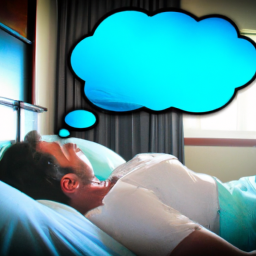Isn’t it strange how vivid our dreams can be? Waking up often feels like we’ve lived a whole lifetime while asleep. Sometimes I wonder if my dreams are more real than reality itself. There is a scientific explanation for why our dreams feel so lifelike.
As it turns out, our brains are incredibly active during sleep. In fact, they’re even more active than when we’re awake! During Rapid Eye Movement (REM) sleep, which is the phase of sleep where most dreaming occurs, our brains are processing information and emotions at an incredible rate.
This is why our dreams often seem to be connected to things that happen in our waking lives – because they quite literally are. But what causes this connection between the events of our waking lives and the content of our dreams? That’s what we’ll explore in this article about ‘why do my dreams happen in real life’.
Key Takeaways
- Dreams can reveal unconscious desires, fears, and anxieties that may not be apparent in waking life.
- Common dream themes often represent underlying fears or anxieties, such as falling, flying, being chased or attacked, and losing teeth.
- Examining dream content can help identify what motivates and fulfills us, and recurring themes and symbols can uncover hidden emotions or desires.
- While relying solely on dream insights for problem-solving can lead to unrealistic expectations, self-awareness gained through dream analysis can empower positive changes in life and relationships.
The Science Behind Our Dreams
You may not realize it, but your brain is constantly creating and processing dreams while you sleep. These dreams occur during the Rapid Eye Movement (REM) cycles of our sleep, which are characterized by increased brain activity.
During REM sleep, our brains become highly active as they process information from the previous day and create new memories. Scientists have discovered that the parts of our brains responsible for learning, emotion regulation, and memory consolidation are especially active during REM sleep. This suggests that dreaming plays an important role in consolidating and integrating new information into our long-term memory.
In addition to this cognitive function, studies have shown that dreaming also helps regulate emotions by providing a safe space to process intense feelings and experiences. As we move into the next section on ‘the role of emotions in dreams’, it’s important to remember that our dreams are not just random images or thoughts. They serve a vital purpose in helping us learn, grow, and emotionally heal from life’s challenges.
The Role of Emotions in Dreams
Emotions play a crucial role in shaping the content of our dreams, allowing us to process and work through complex feelings while we sleep. Dream interpretation experts suggest that the emotions we experience during our waking hours can influence what we dream about at night.
For instance, if you’re feeling anxious or stressed throughout the day, your brain may incorporate these emotions into your dreams. Psychological significance is another aspect of how emotions impact our dreams. Researchers have found that individuals who suffer from post-traumatic stress disorder (PTSD) often have vivid and intense nightmares related to their traumatic experiences.
This phenomenon suggests that there’s a strong connection between emotional distress and dream content. Understanding the role of emotions in dreams can help us interpret and gain insight into our subconscious mind, leading to better mental health outcomes.
Moving on to lucid dreaming, this fascinating topic explores how individuals can take control of their dreams and actively participate in them.
Lucid Dreaming
I’ve always been fascinated by the concept of lucid dreaming. It refers to the ability to consciously control one’s dreams. A lucid dream is a type of dream in which the dreamer knows that they are dreaming and can actively participate in shaping the content of their dream.
There are various techniques for achieving lucid dreams, including reality testing, wake back to bed (WBTB), and mnemonic induction of lucid dreams (MILD).
Definition and Explanation
When we dream, our subconscious mind creates a symbolic representation of our thoughts and experiences. These symbols can be interpreted to reveal spiritual significance and deeper meanings behind our daily lives. Dream interpretation has been used for centuries in various cultures to gain insight into one’s self, relationships, and future.
However, sometimes dreams may feel so real that it becomes difficult to differentiate them from reality. This is where lucid dreaming comes into play. By practicing techniques for achieving lucid dreams, individuals can become aware that they’re dreaming while still in the dream state. This allows them to take control of their dreams and even manipulate the outcomes to their liking.
Techniques for Achieving Lucid Dreams
To achieve lucid dreams, individuals can use various techniques that help them become aware of their dream state and take control of their experiences. One such technique is meditation practices, which involve focusing on breathing and clearing the mind to increase awareness and concentration. This can lead to a greater ability to recognize when one is dreaming and take control of the experience.
Another effective technique for achieving lucid dreams is performing reality checks throughout the day. This involves questioning whether one is in a dream or awake by checking details such as time, location, and physical sensations. By making this a habit during waking hours, it becomes more likely that these reality checks will carry over into dreams and trigger an awareness of the dream state. These techniques have been shown through empirical evidence to be effective in achieving lucid dreaming experiences.
Moving on to why dreams can feel so real, there are several cognitive and emotional factors at play that contribute to this phenomenon. While we may not fully understand the mechanisms behind it, research has shown that our brains create complex scenarios during sleep based on our past experiences, emotions, and beliefs. These scenarios can feel just as vivid as waking life due to the activation of similar neural networks in the brain.
Why Dreams Can Feel So Real
Imagine yourself in a world where your dreams feel as vivid and tangible as reality, leaving you questioning what’s truly happening. This experience isn’t uncommon, and there are scientific explanations for why dreams can feel so real.
It all comes down to the brain activity during sleep, particularly during the REM (rapid eye movement) stage. During this stage, the brain is highly active and sends signals to different parts of the body that can cause sensory experiences such as sight, sound, touch, smell or even taste. This process creates a simulation of reality that can be difficult to distinguish from actual events.
Studies have shown that certain areas of the brain responsible for memory and perception are also activated during dreaming which may contribute to the feeling of familiarity in dream scenarios. While it may be unsettling at times when we cannot differentiate between our dream state and reality, understanding how our brains work during sleep can help us appreciate this unique aspect of human experience.
As fascinating as it is to explore the science behind realistic dreams, there are other common themes in dreams worth exploring. These themes often reflect subconscious thoughts or emotions that we may not be fully aware of while awake. Let’s delve deeper into some examples of these recurring motifs in our next section.
Common Themes in Dreams
Get ready to discover the fascinating recurring symbols in your dreams that can reveal your deepest thoughts and emotions. These motifs can vary from person to person, but some common themes include falling, flying, being chased or attacked, and losing teeth.
These symbols often represent underlying fears or anxieties that we may not even be aware of while awake. Interpretation techniques for these symbols involve examining their context within the dream and considering personal associations with them.
For example, if someone often dreams of falling while on a high building, it may indicate a fear of failure or losing control in a particular area of life. Exploring these recurring symbols can provide insight into our subconscious minds and help us better understand ourselves.
With this knowledge, we can work towards resolving internal conflicts and achieving personal growth. Theories on the meaning of dreams range from Freudian psychoanalytic interpretations to more modern cognitive theories.
Understanding these theories can further enhance our understanding of the significance behind our dreams.
Theories on the Meaning of Dreams
Common themes in dreams can vary from person to person, but they often involve familiar people or places, recurring situations, and unresolved emotional conflicts. As someone who’s experienced vivid dreams that seem to play out in real life, I’ve often wondered about the meaning behind these experiences. This curiosity led me to explore theories on the interpretation of dreams.
One perspective is the psychoanalytic approach, which suggests that dreams are a reflection of our unconscious thoughts and feelings. According to this theory, dream symbols represent repressed desires or fears that we may not be aware of consciously.
Another theory is symbolic interpretation, which posits that the images and events in our dreams reflect broader cultural or universal meanings. By analyzing these symbols and themes, we can gain insight into our own psyche as well as the collective human experience.
To further engage with this topic, consider reflecting on a recent dream you had and trying to interpret its meaning through either a psychoanalytic or symbolic lens. You could also research case studies of individuals who have used dream analysis for personal growth or therapeutic purposes.
While there’s no one-size-fits-all answer to why our dreams happen in real life, exploring different interpretations can provide valuable insights into our inner world. By paying attention to recurring themes and symbols in our dreams, we may uncover hidden emotions or desires that we were previously unaware of. In turn, this self-awareness can empower us to make positive changes in our lives and relationships.
Understanding the possible meanings behind our dreams is just one way they can serve as a window into deeper aspects of ourselves. In the next section, we’ll delve further into how examining our dreams can reveal inner thoughts and feelings that may be influencing us subconsciously.
How Dreams Can Reveal Our Innermost Thoughts and Feelings
I find it fascinating how dreams can reveal our innermost thoughts and feelings. Through analyzing dream content, I’ve learned that our unconscious desires, fears, and anxieties can often manifest themselves in our dreams.
Additionally, dreams can serve as a way for our minds to work through problems and find solutions to real-life issues.
The study of dreaming provides valuable insights into the complexities of the human mind.
Unconscious Desires
You may not realize it, but your dreams could be manifestations of your unconscious desires. Our dreams are often filled with symbolic representations of our hidden desires that we may not even be aware of while awake.
For instance, dreaming about being in a luxurious mansion could represent a desire for wealth and success, while dreaming about flying could indicate a longing for freedom and independence.
Studies have shown that over 80% of our dreams are related to unfulfilled wishes and needs. This suggests that our subconscious plays an important role in shaping our dream experiences.
By examining the content of our dreams, we can gain insight into what truly motivates us and what we need to feel fulfilled in life. However, it’s important to note that not all dreams are straightforward representations of our desires – some may also be influenced by fears and anxieties which we’ll explore next.
Fears and Anxieties
If you’re experiencing fears and anxieties in your dreams, it could be a sign of underlying emotions that need to be addressed. Dreams are often influenced by our subconscious thoughts and feelings, which can reveal deep-seated fears or unresolved psychological issues.
The impact of these fears and anxieties on our mental health can be significant, affecting our mood, behavior, and overall well-being.
To cope with these intense emotions in your dreams, there are several strategies you can employ. One approach is to practice relaxation techniques before bed, such as meditation or deep breathing exercises. Additionally, seeking professional help from a therapist or counselor can provide valuable insight into the root causes of your anxiety and offer effective coping mechanisms for managing it.
It’s important to remember that addressing fears and anxieties takes time and effort but acknowledging them is the first step towards finding solutions that work for you.
Moving forward towards problem-solving requires a proactive mindset where we take action to face our fears head-on instead of avoiding them.
Problem-Solving
Unlock the doors to a brighter future by breaking down obstacles and finding creative solutions through problem-solving in your dreams. Dreams are often seen as an abstract representation of our thoughts and emotions, but they can also serve as a platform for discovering innovative problem-solving techniques. By tapping into our subconscious mind, we can access new perspectives that may not have been apparent in our waking life.
However, there are both benefits and drawbacks to using dreams as a problem-solving tool. On one hand, dreams provide a safe space to explore potential solutions without fear of failure or judgement. Additionally, dream insights can be integrated into waking life and lead to more successful outcomes. On the other hand, relying solely on dream insights can lead to unrealistic expectations and may not always result in practical solutions. It is important to approach dream problem-solving with caution and balance it with real-world action steps.
Transitioning into the subsequent section about ‘tips for better dream recall’, one effective technique is keeping a dream journal next to your bed to record any vivid details upon waking up.
Tips for Better Dream Recall
Improve your dream recall by keeping a journal and jotting down any details you remember as soon as you wake up. This technique is called dream journaling, and it’s been proven effective in enhancing dream recall.
Here are some tips for better dream journaling:
- Keep a notebook or voice recorder near your bed to capture your dreams immediately upon waking.
- Record as much detail as possible, including emotions, colors, people, places, and events.
- Use present tense when writing about your dreams to help keep them fresh in your mind.
By consistently using these techniques for better dream recall, you’ll be able to remember more of your dreams and gain insight into the workings of your subconscious mind.
Remember that practice makes perfect – the more you work at it, the easier it becomes!
Frequently Asked Questions
What are some common dream symbols and what do they mean?
I’ve had recurring dreams of falling, which I interpret as feeling out of control in my life. Interpretation methods suggest analyzing emotions and symbols in dreams to uncover subconscious desires. Common dream symbols include teeth falling out (anxiety) and flying (freedom).
Can eating certain foods before bed affect our dreams?
Eating certain foods before bed can impact sleep quality and subsequently affect our dreams. Foods rich in tryptophan, like turkey or bananas, may increase melatonin production leading to more vivid dreaming. However, consuming heavy or spicy meals can disrupt sleep and dream recall.
How do medications or drugs impact our dreams?
I once took a medication that caused vivid nightmares. Side effects of drugs can impact dreams, often leading to lucid dreaming. Research shows medications like antidepressants and beta-blockers can also alter sleep patterns, affecting dream content.
Are there any cultural differences in how dreams are perceived or interpreted?
Cultural variations exist in how dreams are perceived and interpreted, with psychological implications. For instance, some cultures view dreams as prophetic while others see them as a manifestation of subconscious desires. Evidence-based research highlights the importance of cultural context in dream analysis.
Can dreams predict the future or provide insight into past events?
Exploring dream interpretation and analyzing scientific studies, there is no empirical evidence that dreams can predict the future or provide insight into past events. However, some people may find personal meaning in their dreams that aids in emotional processing and growth.
Conclusion
In conclusion, dreams can be a fascinating and mysterious aspect of our lives. Through scientific research, we’ve learned about the different stages of sleep and the role they play in our dream experiences.
Emotions can also heavily influence dream content, leading to common themes such as falling or being chased. The phenomenon of lucid dreaming allows individuals to gain control over their dreams and potentially achieve new levels of self-awareness.
Despite the many theories on the meaning behind our dreams, it’s ultimately up to each individual to interpret their own experiences. Whether it’s through analyzing recurring symbols or examining personal emotions, dreams can offer insight into our innermost thoughts and feelings.
By improving dream recall through techniques such as journaling or setting intentions before sleep, we can better explore this unique aspect of human consciousness. Using parallelism in the final sentence emphasizes the importance of taking an active approach towards understanding our dreams.
Just as we must actively strive for better dream recall, we must also take an active role in interpreting and making sense of these subconscious experiences. Our dreams may feel like they’re happening in real life, but with curiosity and exploration, we can unlock their hidden meanings.









